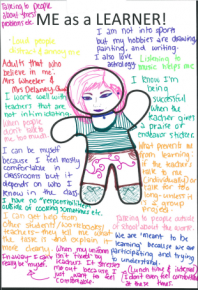Secondary school leaders recognise the power of learner agency
Tags: Teacher inquiry | Collaborative tools | e-Portfolios | Secondary |
Suzanne Baldwin and Lizzy Harrison, Burnside High School, addressed the needs of 13 target learners by making learner agency a core focus for their inquiry.
These Heads of Faculty used Timperly, Halbert, and Kaser’s (2014) Spirals of Inquiry as a framework for their inquiry in 2015.
Scanning for impacts on student learning
Lizzy and Suzanne began by scanning, or determining what impacted most on their target students’ learning. They supported their target students to reflect on their learning with questions:
- How do you know what you’re meant to be learning?
- What helps you learn internally?
- What helps you learn externally? (places/tools/people)
- What prevents you from learning?
The students' reflections were used as a starting point to develop a set of questions that allowed the teachers to think more holistically about their students' current situation.
“I found through the scanning process I was much more focused on a range of different things that were impacting or influencing students learning.”
Focusing the inquiry: Analysing student reflection
Analysing student reflections
Lizzy and Suzanne analysed the students' reflections on what it meant to be a successful learner. They found that students typically believed that being successful was "focused on getting work done”, and, “finishing work”. Students reflected that being successful conflicted with their drive to be sociable, resulting in chatting or using their mobile phones during independent work.
“In the past, we’ve looked at data and numbers and have forgotten about who the kids are – we will look at ways to scan more effectively.”
Using the 7 Principles of Learning
Using the 7 Principles of Learning to inform their reflections, Lizzy and Suzanne understood their students were experiencing:
- Lack of control – learners feel “done to” by teachers (Principle 1: Learners at the centre).
- Social distractions – learners may not be well supported to learn collaboratively (Principle 2: Social nature of learning).
- Focus on the finished product – learners emphasise output over process. Learners don’t have a growth mindset about learning (Principle 6: Assessments for learning).
Further questions
Following the analysis, more questions were asked, taking the teachers back to the scanning phase:
- Can learners describe what quality work looks like?
- Can learners answer the question, “Where are you going next with your learning?"
- Do learners demonstrate the kinds of social and collaborative skills needed for teamwork, citizenship, and the workplace?
- Many of the learners are Māori – can they locate themselves culturally? What are their beliefs and their parents' beliefs about the importance of this?
- Do learners engage more in learning if they are able to work collaboratively?
Analysing teacher practice
With new insights into their students’ learning experience, Lizzy and Susanne questioned their own practice through the lens of their students’ inquiry:
- Do I do too much talking?
- Are the students really engaged in their learning?
- How much group work versus independent work do I encourage, and what is the best approach for my learners?
- Can my learners use a range of ways to demonstrate their learning?
- Are they able to set specific learning goals and construct their own learning?
“It brought to the fore some beliefs about how I viewed myself as a teacher such as the need to make more explicit the focus on developing capabilities in the learning.”
Using digital technologies: Teacher collaboration and learner agency
Digital technologies began to emerge as possible tools for addressing two key areas of the inquiry
1. Learner agency
- New Visions Cloud Lab , an online classroom, was set up for learners to create learning rubrics that could be used as guides for self-regulation and reflection.
- Mobile technologies were used as a means of engaging students.
- Online learning journals shifted emphasis away from the idea of work as a final product towards a view of work as a process of reflected learning.
2. Collaboration
- Google Docs allowed Lizzy and Suzanne to work collaboratively through the process of inquiry with each other, and other teachers.
- Twitter helped them connect with experts and educators using the same inquiry focus.
- Toolkit for innovative teaching and learner success ensured that their solutions were fit for purpose.
- The blogs of secondary teachers who are effective at putting learners at the centre and at harnessing the social nature of learning were explored, for example, Steve Mouldey .
“Throughout the process I was developing a deeper understanding of concepts such as agency and collaboration; really considering what they meant and how I was implementing them into my practice.”
Taking action: Changing practice to increase learner agency
“The inquiry challenged me to think further about what I was doing and why.”
Build a growth mindset
Suzanne implemented shifts in practice in order to build self-regulation in her students. Initially she trialled approaches that shifted her away from being the “sage on the stage”, towards being a “guide on the side”. She noticed a change in learners as she trialled this change, but also recognised that specific approaches were needed to support her students in understanding how to manage their own learning. Building a growth-mindset among her learners was key to supporting them in managing their own learning.HEADER Inquiry outcomes
“It was surprising that the students who are good, self-regulated learners need my guidance far less than I imagined. When they have a structure of learning in place, they are able to go for it.”
Improved engagement in some learners has been observed, while others have received Achieved or Achieved with Merit. In some cases, the learners exceeded expectations and made accelerated progress, while in others, the learners met expectations and made normal progress in their learning.As the end of 2015 approached, both leaders were entering into a more deliberate focus on Taking Action and Checking (Spirals of inquiry ).

